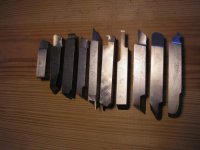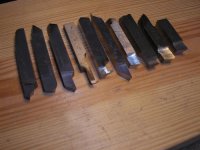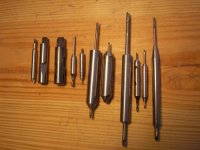Ok - more explination . . .
Rusty, Some of these tools I have had for 40'ish years, and are still good. The problem with the replaceable tools is expence, keep it simple for the simple folks. If you have the tooling to check the tools you are grinding, it is not a problem getting them correct. The Threading tool is about the only one that I would conceve to use as a replaceable tool. I have used them, but not for a small one man operation. Most of them are carbide, and if you ding one of them you have to replace it - unless you are in the lucky group that are able to afford a diamond grind wheel set up. I still have a tool that I made up to do threading with that has a carbide insert on it, use it mostly for things too hard to use High Speed Steel cutters on. Carbide has it's application, but it has a negative rake and most of the high carbon steels (Barrels 4130-4140 @ 26-32 RC) don't like that rake on it, it has a tendency to push off the material instead of cutting it off, makes for a lousy looking thread. To each is own, but the question on this link was how to "grind tools" not buy them, not getting testy, just a point . . .
The other point to be made here is the cost of the set up tooling that goes along with the carbide inserts, that tooling is not always made for the smaller machines. Most of the machines we had in the shops were 14" - 36" lathes and that 1/2" - 3/4" tooling is very available, but some of the small lathes today are not set up for that size tooling. Several of the tools that I use I had to modify to use in my 10" lathe, even the 1/2", it sticks out too far making a cantaleavered tool that can catch and tear up a machine. If you have a milling machine and can modify the tooling that is good, but if you don't then you are at the mercy of the manufacturer. I have a cut off tool that I had to modify even to use in the shop when I was working, it "just" does work in my little lathe. Where - if you can grind your own tools, and get fairly profecient at it, you can buy 1/4" - 1/2" tools at a reasonable price and girnd them and re-use them for years. As you can see from the pictures posted that some of the tools are ground a long way back from the leading edge of the orginal tool, it keeps cutting every time I re-grind it. Some of these tools - I just dust them off to regain the sharp edge, I don't completly re-grind every time. And as I said, they are 40'ish years old, and they show the length of time in their grinds.
Phantom
 . . . This is a picture of the end of them, you can see the clearance grind on them.
. . . This is a picture of the end of them, you can see the clearance grind on them.  Next is a picture of some of the Small Single Point and double point tools that I have made over the years. The biggest tool dia. there is 3/8" and down to 3/16". Just thought I would add them incase some one thought I was blowing smoke . . .
Next is a picture of some of the Small Single Point and double point tools that I have made over the years. The biggest tool dia. there is 3/8" and down to 3/16". Just thought I would add them incase some one thought I was blowing smoke . . .  You have to have a special grinder to make these tools and it is a very careful grind to do. Some are double flute and some are single flute, and the small one on the end is a threading tool. I guess they will come out like they are supposed to. Perhaps this will help, any more questions feel free to ask. . . I'll check on this site daily . . .
You have to have a special grinder to make these tools and it is a very careful grind to do. Some are double flute and some are single flute, and the small one on the end is a threading tool. I guess they will come out like they are supposed to. Perhaps this will help, any more questions feel free to ask. . . I'll check on this site daily . . . 